Home | Category: Commercial and Sport Fishing and Fish / Economics, Fishing and Agriculture / Government, Infrastructure, Economics / Economics, Fishing and Agriculture / Government, Infrastructure, Economics / Government, Infrastructure, Economics / Government, Infrastructure, Economics / Government, Infrastructure, Economics / Government, Infrastructure, Economics / Government, Infrastructure, Economics / Government, Infrastructure, Economics
BOTTOM TRAWLING
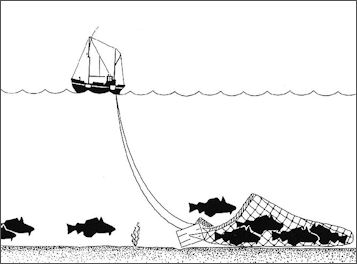
Bottom Trawling A trawl is a conical or sack-shaped net which is pulled through the sea or over the ocean floor by a vessel known as a trawler. The net is held open with buoys at the top of the net and weights at the bottom. Those that are pulled through the sea are pulled to a depth of 400 meters and can capture 40 tons of fish. Bottom Trawls are used to catch bottom dwellers like shrimp, cod, flounder, and pollock.
Bottom trawling is a fishing practice that herds and captures the target species, like ground fish or crabs, by towing a net along the ocean floor. Floats are attached to the headrope, top of trawl opening, while weights and special gear are attached to the footrope, bottom of trawl opening, to keep the net open as it moves through the water across the ocean floor. The mesh is designed to confine fish inside the net, trapping them in the codend as the trawl is hauled to the surface. A sweep attached to the net's footrope collects marine animals as they lay on the bottom or gather before the trawl opening. [Source: NOAA]
About 32 percent of Europe’s fish are caught by industrial fishing vessels that employ bottom trawling and rake the sea floor with enormous nets. Target species in the U.S. include whiting, red hake, dogfish, crab, shrimp and flounder The trawl gear may be constructed and rigged for various target species over different types of bottom surfaces. Sweep types include: 1) Chain sweep for smooth surfaces; 2) Cookies (small steel or rubber rollers) for soft and irregular ocean floors; 3) Rockhoppers (large molded rubber rollers) for rocky bottoms; 4) Raised footropes that reduce groundfish bycatch. [Source: The Guardian NOAA]
Related Articles: COMMERCIAL FISHING: CONSUMPTION, DEMAND, LEADING NATIONS, SPECIES ioa.factsanddetails.com ; HISTORY OF FISHING: IN THE PREHISTORIC, ANCIENT, MEDIEVAL AND MODERN ERAS ioa.factsanddetails.com ; BENEFITS OF EATING FISH AND CHOOSING THE BEST FISH TO EAT ioa.factsanddetails.com ; COMMERCIAL FISHING INDUSTRY: TECHNOLOGY, SECTORS, PROBLEMS ioa.factsanddetails.com ; OVERFISHING: CAUSES, EFFECTS AND SOLUTIONS ioa.factsanddetails.com ; ILLEGAL OCEAN FISHING ioa.factsanddetails.com ; AQUACULTURE AND FISH FARMS ioa.factsanddetails.com ; CATEGORY: COMMERCIAL AND SPORT FISHING AND FISH ioa.factsanddetails.com
Problems with Bottom Trawling
Nets that are dragged at the bottom of the ocean for shrimp, scallops and oysters are very destructive. They tear up habitats of all kinds of marine life, often destroying sponges and coral and rocky nooks where baby fish hide out. By some estimates bottom drag nets destroy a larger area than destroyed rain forests every year. According to The Guardian: Studies indicate that these nets can suck up to 41 percent of all invertebrate life from the sea floor and cause grave damage to marine environments such as cold water coral reefs and seagrass beds. Some research also suggests that beyond biodiversity loss, sedimentary disturbances from bottom trawling may cause more carbon dioxide releases than the world’s entire aviation fleet. [Source: Arthur Neslen, The Guardian, February 17, Feb 2022]
Compared to clear cutting the ocean floor, bottom-scouring trawling is one of the damaging forms of fishing. It indiscriminately targets certain areas without going after specific fish. Much of the catch is bycatch and the result is often overfishing of both target fish and non-target fish and destruction of the sea floor. The method is particularly damaging on seamounts where many forms of unique life forms are found, the majority of which have not been studied by scientists. Even the tops of seamounts in the middle of the ocean, 800 meters below the surface, have been for all intents and purposes scraped clean or “torn up, crushed and crumbled” in the words of marine biologist Callum Roberts.
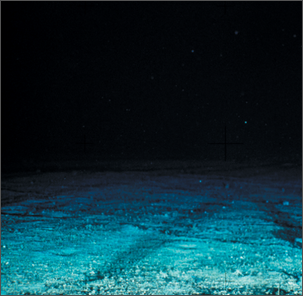
ocean floor scraped by bottom trawling In the deep sea “rockhopper” trawling nets mounted on massive rollers are dragged across the seabed. A single trawl can tear away five tons of sponges, coral, fish and sea creatures. Most of the catch is thrown out. The sea floor is left as lifeless as a desert. Ocean biologist Sylvia Earle compared it to using bulldozers to catch squirrels. Also nasty are trawling nets held open by heavy doors that bulldoze the sea bed. More than 50 percent of the catch is unwanted species. These are now banned in many countries The European Union has called for a ban or bottom trawling to save bycatch and prevent damage to the ocean floor.
Risks to Sea Turtles: Many sea turtle species rest and forage on the bottom and are at risk of being captured in bottom trawls. Capture in a bottom trawl could result in: 1) Drowning from being trapped in the net and held underwater for the duration of the trawl. 2) Broken appendages or shell from the weight of the catch on top of them. 3) Injury from the drop to the deck when the net is emptied aboard the fishing vessel. 4) Stress and exhaustion from capture and release. [Source: NOAA]
Risks to Marine Mammals: Marine mammals can become entangled by trawl gear when swimming to forage or migrate, with risks differing widely between species. Species that forage on or near the sea floor are at risk of being captured or entangled in netting or tow lines (also called lazy lines). Pilot whales and common dolphins in the Atlantic are particularly susceptible to being caught in bottom trawls.
Bycatch Reduction: Sea turtle mortality in trawl gear was once very high. Turtle excluder devices have greatly reduced these risks in some trawl fisheries and might even allow small cetaceans to escape as well. TEDs are currently only required in trawl fisheries targeting shrimp and summer flounder.
Some recommended voluntary mitigation measures for reducing marine mammal bycatch include: 1) Reducing the number of turns per tow at night. 2) Reducing the duration of each tow. 3) Encouraging frequent radio communications between between captains to raise awareness of nearby animals.
Europe’s Fishermen Battle Conservationists over Bottom Trawling
As of 2022 bottom-trawling was banned by the European Union (EU) at depths of more than 800 meters but the European Commission (EC) at the time said it would do everything possible to restrict the practice, which it deemed “the most damaging activity to the seabed”. In the spring of 2022 the EC recommended that a ban on bottom-trawling in marine protected areas (MPAs) be put in place. An alliance from 14 nations — the European Bottom Fishing Alliance (EBFA) — pledged to fight the ban. [Source: Arthur Neslen, The Guardian, February 17, Feb 2022]
The Guardian reported: The EBFA was formed in response to a petition signed by 150,000 people in December 2021 calling for an immediate ban on bottom trawling in MPAs. The group argues that bottom trawling is “very sustainable” because of certification schemes such as the one run by the Marine Stewardship Council and because vessels already have to comply with environmental constraints imposed by the EU’s common fisheries policy.
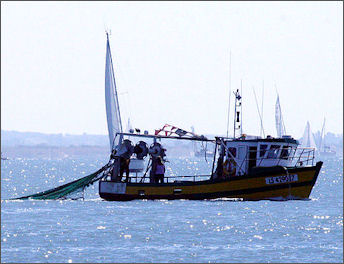
trawler New trawling curbs could create a supply squeeze with the potential to price many common fish species such as sole, turbot, plaice, halibut and shrimps out of European menus, EBFA says. “We don’t want to see an industry catering for the rich,” said Ivan López, chair of EBFA, who runs a trawling business in Spain. “It would not be fair if fish became a luxury product.” Seafood is a “culture and identity” issue in Spain, he added.
Others are critical of these arguments. While trawling restrictions could raise prices for a period, said Joachim Claudet, a senior scientist at France’s National Centre for Scientific Research, “ecosystems would recover quite quickly if we stopped trawling, and that would mean there would be more fish to catch with more sustainable practices.”
Brussels has pledged to establish protected areas for at least 30 percent of Europe’s seas but, under EU law, MPAs have specific objectives, such as protecting seabirds, crustaceans or other marine features. Their effectiveness is contested, however. Fournier said that their benefits often exist mainly on paper and that shipping, dredging, oil and gas drilling, aquaculture, harbour developments and windfarms can still be permitted in MPAs.
One tenth of Europe’s waters have marine protected status but more than 2.5 meters hours of bottom trawling took place within them in 2020, according to research by Oceana. “In some areas, bottom trawling is prohibited in order to protect the seabed, but many other [MPAs] focus on other features and therefore don’t regulate bottom trawling,” said one EU official, who did not want to be named. Sttudies by the University of Washington academic Ray Hillborn to support its case for allowing bottom trawling in MPAs on a case-by-case basis — in areas where seabirds are being protected but the seabed is not, for example.
Fishers, like farmers, carry significant lobbying clout but many believe they have lost out in debates over catch limits and Brexit, and could now bump up against further restrictions. “We feel that the green deal is pushing too much on to the fisheries,” said Lopez. “We feel the argument is too skewed in one direction on the [environmental] issue,” he added, “and it’s not ours.”
Midwater Trawling
Midwater trawling is a fishing practice that herds and captures the target species by towing a net through the water column. Similar to bottom trawling, midwater trawling involves towing a large net through the water column. Trawls are designed to capture and trap the target species inside the codend as the net is hauled through the water. [Source: NOAA]
Target species include squid, shrimp, pelagic schooling fish, such as sardines. Trawl nets vary in length, mesh size, material, and tow speed depending on target species, but most are constructed of four mesh panels sewn together. Beam trawls consist of a cone-shaped net with a horizontal opening that narrows to the codend. Otter trawls use boards, called doors, secured at the mouth of the net to ensure that the net remains open throughout the trawl.
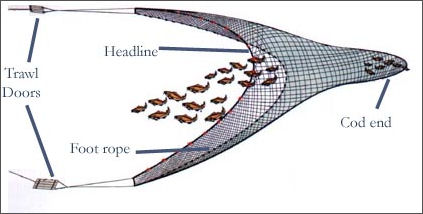
trawl used in open water Sea turtles are at risk of being captured in midwater trawls as they transit from the bottom, where they rest and forage, to the surface, where they breathe. Because turtles have lungs as humans do, the likelihood of drowning increases the longer a turtle is held underwater. Turtles can be crushed by the weight of the catch on top of them, resulting in broken appendages or shell. Injury may also occur when the net is emptied onto the fishing vessel and turtles are dropped onto the hard deck along with the catch. The stress of being captured can leave turtles exhausted and barely alive when they are tossed back into the water.
Risks to Marine Mammals: Many species of marine mammals forage and swim at midwater depths, putting them at a high risk of being captured or entangled in these trawls. As marine mammals are swimming to forage and migrate, trawling vessels can entangle these animals in netting and tow lines or even cause disorientation due to vessel noise. In the Northeast United States, pilot whales and white-sided dolphins are particularly susceptible to being caught in midwater trawls in nearshore areas. Bottlenose dolphins are particularly susceptible to being caught in midwater trawls in nearshore areas in the Southeast United States. Killer whales and Steller sea lions are occasionally captured in the Alaska Region.
Bycatch Reduction: Sea turtle mortality in trawl gear was once very high. Turtle excluder devices have greatly reduced mortality in some trawl fisheries. If small and juvenile cetaceans reach the codend of the net, they may also be able to escape through the TED if not entangled. Mitigation measures are similar to those recommended for bottom trawling, such as reducing the number of turns per tow and tow duration. Ongoing research is investigating how animals might behave differently when in vicinity of fishing vessels and assessing potential gear modifications that might lead to animals avoiding trawls.
Skimmer Trawling
Skimmer trawls differ from most other trawls in that vessels push nets in shallow, nearshore waters. A skimmer trawl consists of an L-shaped frame constructed from metal pipe, which keeps the trawl mouth open. Skimmer frames keep the net on the bottom but are flexible to glide over obstacles. A chained footrope and the tickler chain are used to stir up the bottom and raise the catch into nets ranging from 25 to 72 feet across. [Source: NOAA]
The main target species is shrimp. Skimmer trawls are fished from booms on either side of the vessel. Nets remain in the fishing configuration while the codend is emptied (approximately every half hour), allowing fishermen to more quickly retrieve the catch.
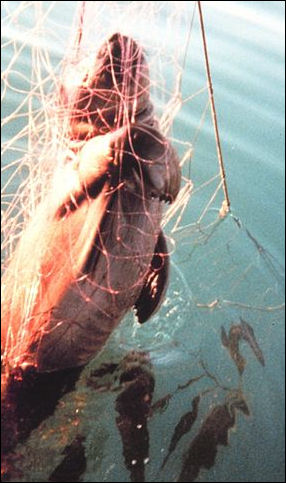
Sea turtle entangled in net Risks to Sea Turtles: Sea turtles can become captured in skimmer trawls as they rest and breathe at the surface. Because skimmer trawls operate in shallower depths with shorter tow times, mortality has historically been considered low for this fishery. Fishermen empty the net throughout the tow so turtles are not held underwater for prolonged periods of time and often can be brought on board soon after they are observed captured. However, stress and injury can still occur within the trawl, including broken appendages and entanglements around the head, neck, or flippers.
Risks to Marine Mammals: Small cetaceans, like dolphins and porpoises, spend the majority of their time at the surface of the water while swimming and can easily become caught in the path of skimmer trawls. While shorter tow times at the surface allow fishermen and observers to more quickly identify, respond to, and release entangled marine mammals, being caught in fishing gear can still be stressful and may cause lasting damage. Smaller marine mammals such as harbor seals, common dolphins, and bottlenose dolphins can become twisted and wrapped in netting while trying to escape, making it even more difficult to facilitate safe release.
Bycatch Reduction: NOAA Fisheries observers deployed on skimmer trawl boats have helped characterize bycatch for this gear type, although the amount of observer coverage is very limited and more sea turtle bycatch data is needed. NOAA Fisheries has partnered with the fishing industry to develop turtle excluder devices for skimmer trawls that reduce bycatch of sea turtles.
Dredges
Dredging sounds even worse than bottom trawling. It is a fishing method in which a dredge is dragged across the sea floor, either scraping or penetrating the bottom. A typical dredge consists of a mouth frame with an attached collection bag. Target species include oysters, scallops, clams, mussels, crabs, sea urchins, sea cucumbers and conch. [Source: NOAA]
Dredge construction, tow time, and tow patterns vary depending on the area being dredged, species targeted, and the local density of that species, but common features of dredge fisheries include: A) 2.5 knot tows with decreasing speed as catch accumulates; B) 15 minute tows; and C) scraping dredges that collect animals in the top layer of seafloor sediment with rakes or teeth that scoop up the substrate. Penetrating dredges use pressurized water jets to chase animals out from beneath muddy or rocky bottom substrate and into the collection bag.
Risks to Sea Turtles: The injury of loggerhead, Kemp's ridley, and green sea turtles is common and well-documented in dredge fisheries. Slower tow speeds sometimes allow animals to avoid capture or entanglement. However, dredging can be harmful to the prey species and habitat turtles depend on for survival. Dredges, when towed across the sea floor, can crush turtles or capture them in the collection bag. Large rocks that accumulate inside the collection bag can damage the shell of captured sea turtles. However, short tow times may lower the drowning incidence of captured juvenile turtles in dredges. Captured turtles may also become injured when they are dropped on the boat deck as the collection bag is emptied.
Risks to Marine Mammals: The risks to marine mammals from dredging are similar to the risks from bottom trawling. Many species of marine mammals forage on or near the sea floor and are at risk of being captured or injured in dredging gear. Pilot whales and common dolphins in the Atlantic are particularly susceptible to being injured by dredging in nearshore areas. In addition to being captured, small cetaceans, like dolphins or porpoises, can become entangled in the tow lines. Mortality is considered low for this fishery type because slower tow speeds allow whales and dolphins to avoid capture or entanglement. However, dredging can be harmful to the prey species and habitat marine mammals depend on for survival.
Bycatch Reduction” NOAA Fisheries recommends that fisheries use observers and modified gear during seasons and in areas where sea turtles are likely to occur. Vessels in the Atlantic Sea Scallop fishery are required to use turtle deflector dredges in certain areas and seasons, which block the entrance to the dredge and deflect turtles over the top of the frame. Additionally, these vessel operators must also install chain mats at the opening of the dredge collection bags to block turtles from the entrance. However, chain mats can lead to underestimating bycatch in this gear type because turtles that are hit or injured by the dredge are no longer hauled up with the catch and cannot be counted.
Drift Nets

drift net
Described as "strip mining of the sea" drift nets were banned in 1992 under pressure from the United Nations. Before that it was is estimated that the number of birds, marine mammals and unwanted fish killed by drift nets from Japanese, Korean and Taiwanese fishing boats far outnumbered all the fish sold in markets. They are still used in some places and are used by illegal fishermen.
Drift nets hang vertically in the water column without being anchored to the bottom. The nets are kept vertical in the water by floats attached to a rope along the top of the net and weights attached to another rope along the bottom of the net. They generally rely on the entanglement properties of loosely affixed netting. Folds of loose netting, much like a window drapery, snag on a fish's tail and fins and wrap the fish up in loose netting as it struggles to escape. The nets can also function like gill nets if fish are captured when their gills get stuck in the net. The size of the mesh varies depending on the fish being targeted. These nets usually target schools of pelagic fish. [Source: Wikipedia]
Drift nets were sometimes dragged between two boats, sometimes as far as 48 kilometers (30 miles apart). The net was typically 15 meters deep and it picked up everything in its path: fish turtles, dolphins as well as commercial fish. They were used primarily to catch squid and tuna. Most of the other fish caught were tossed overboard. Half the catch typically was unwanted.
Drift net fishing was popular because it was cost effective. Nets could be placed by low-powered vessels cutting fuel costs and the nets were effective at bringing in large amounts of fish in one catch. Traditionally drift nets were made of organic materials, biodegradable such as hemp. Prior to 1950, nets tended to have a larger mesh size designed to catch larger fish, and allowing smaller, younger ones to slip through. When drift net fishing became popular in the 1950s, the industry changed to synthetic materials with smaller mesh size. Synthetic nets last longer, are odorless and may be nearly invisible in the water, and do not biodegrade.
Gill Nets
A gillnet is a wall of netting that hangs in the water column Mesh sizes are designed to allow fish to get only their head through the netting but not their body. The fish's gills then get caught in the mesh as the fish tries to back out of the net. As the fish struggles to free itself, it becomes more and more entangled. A variety of regulations and factors determine the mesh size, length, and height of commercial gillnets, including area fished and target species. [Source: NOAA]
Gill nets are typically made of monofilament mesh or multifilament nylon. They are invisible in the water and trap fish that swim into them usually by ensnaring them in the gills. They resemble volleyball nets, except with much larger mesh and have floaters at the top and weights on the bottom portions that keep the net upright and taut. Gil nets can be up to five kilometers (three miles) long and ideally set in the path of moving fish. Typically one end of the net hangs from a boat and the other end is set in place with a buoy and anchor. The fish’s heads pass through the net but their bodies do not and the gills catch in the net, preventing the fish from backing out.
There are two main types of gillnets: 1) Set gillnets are attached to poles fixed in the substrate or an anchor system to prevent movement of the net. 2) Drift gillnets are kept afloat at the proper depth using a system of weights and buoys attached to the headrope, footrope, or floatline. Target species include salmon, groundfish:, cod, haddock, pollock, flounder, hake, barracuda, herring, mullet, rockfish, seabass, shad, sharks, sturgeon, swordfish, tuna,

gill net
Problems with Gill Nets
Gill nets are sometimes called “curtains of death” because of the way the indiscriminately kill. Many sea animals become entangled in them and the more they struggle to get out the more entangled they get. Sea mammals and reptiles such as dolphins and turtles are particularly vulnerable because the nets prevent them from coming to the surface to breath. The United Nations banned gill nets more than a mile long. Gill nest have largely been replaced by long lines.
Risks to Sea Turtles: Gillnetting has been a major source of mortality for all sea turtle species. Turtles encountering a gillnet can quickly become entangled around their head or flippers as they try to escape. Entangled turtles will drown if held under the water but have a higher chance of survival if they can reach the surface to breathe. The nylon can tighten around the turtle's soft body parts and cause deep cuts potentially leading to infections, limited movement, or complete loss of the limb. Limited use of appendages can impair a turtle's natural feeding, breathing, and swimming behavior. [Source: NOAA]
Risks to Marine Mammals: Gillnets can entangle a wide variety of marine mammals. Depending on the gillnet mesh size, animals can become entangled around their necks, mouths, and flippers. Entanglement can prevent proper feeding, constrict growth, or cause infection after many months. Marine mammals entangled in set gillnets can drown while those entangled in drift gillnets can drag gear for miles as they migrate and forage, leading to extreme fatigue. Species most commonly caught in gillnets include: Large whales, Humpback whales, Fin whales, Right whales, Harbor porpoise, Dolphins, Bottlenose dolphins, Common dolphin, Right whale dolphins, Steller sea lions, Gray seals
Bycatch Reduction: Many factors have been studied in trying to minimize incidental capture, including adding breakaway panels and changing net slack, mesh size, and set depth. Current regulated mitigation measures in the U.S. include: 1) Seasonal and regional pinger (acoustic device) used to warn cetaceans are required in California and Maine through New Jersey; 2) Prohibitions on large mesh gillnets; 3) Closures of certain fishing areas at certain times (known as time/area closures); and 4) Inserting weak links into gillnets to allow large whales to break free when entangled.
Longlines
Longlines are strong fishing lines that extend for up to 130 kilometers that have thousands of baited hooks attached to them. They are dragged through the sea by boats. By one estimate over 100,000 miles of long lines, with 4.5 million hooks, rip through the Pacific Ocean every day. Sometimes they are left out for hours. Sometimes for days. Large fish such as swordfish and tuna are largely caught with longlines. Sixty-eight tons of sailfish were intentionally hooked in 1996 on Atlantic longlines; 227 tons of marlin were unintentionally hooked.
Longlines replaced harpoons in some places as a way of catching big fish. Longlines consist of a mainline, gangions, and baited hooks. A high-flyer buoy is used to monitor gear position while fishing, and lightsticks are often used to target certain species. The longline set can be suspended at any depth within the water column, depending on target species. Hook type varies with different catch species, but J-hooks and circle hooks are most common. Circle hooks are required in Atlantic pelagic longline fisheries. [Source: NOAA]
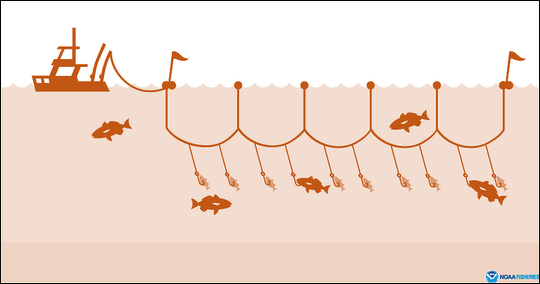
longlines
Target species include tuna and swordfish and other billfish. Once deployed, sets can soak for hours. Bait includes squid, mackerel, and sardines. The average U.S. longline set is 28 miles (45 kilometers) long. There are limits on longline length in areas. Longline fisheries range from local small-scale operations to large-scale mechanized fishing fleets.
Many longline fishing boats are operated by Japan. When post-World-War-II restrictions were lifted in 1952, the Japanese longline fleet quickly expanded across the globe. By 1982 the catch peaked, and Japan began to set restrictions. Longline fleets from other nations joined the hunt in the mid-1960s. The total number of fish caught by Japanese longliners increased from 4 million in 1952 to 14 million in 1966 and then fell to between 6 million and 7 million in the 1980s and started falling below 6 million in the 1990s.
Longlines are prohibited in certain areas to protect endangered animals such seals, sharks, sea turtles and dolphins and reduce the potential for gear conflicts and localized stock depletion. In many places longline fishermen must carry a vessel monitoring system — a satellite transponder that provides real-time position updates and tracks vessel movements to enforce regulations. Longline vessel owners and operators are required to attend annual protected species workshops. In U.S. waters longline fishermen are often required to carry onboard observers when requested.
Problems with Longlines
As much of 30 percent of the sea life caught with long lines is unwanted bycatch that is often tossed overboard dead. Long lines inadvertently kill seabirds, turtles, dolphin, sharks, and marlin. Long lines even snag great white sharks. In the United States an effort is being made to ban longline fishing. American fisherman complain that by banning them they only allow less careful fishermen to move on.
Risks to Sea Turtles: High numbers of sea turtles are incidentally caught in longline fisheries worldwide. Lightsticks may attract sea turtles to the baited hooks. Loggerheads and leatherbacks are the species most commonly captured as bycatch. A hook can penetrate the turtle's flippers, head, mouth, or neck. If a turtle swallows an entire hook, it can become lodged in the turtle's digestive track, thereby hindering normal feeding and digestion, resulting in starvation and possibly death. Entanglements may lead to severe lacerations and infections caused by constriction of the lines on the turtle's soft body. Loggerheads are most often hooked in the mouth or esophagus and are commonly hooked around the front flippers. Turtles entangled or hooked at depth likely drown because they cannot reach the surface to breathe. [Source: NOAA]
Risks to Marine Mammals: Marine mammals are often entangled or hooked in longline gear. Pilot whales and false killer whales are known to steal bait and or target catch from longlines and can thus be hooked in the mouth or entangled in the lines. Risso's dolphins, bottlenose dolphins, and several species of whales have also been documented as longline bycatch. Injuries from these interactions can include lacerations, puncture wounds, exhaustion, and drowning.
Bycatch Reduction: Current bycatch reduction measures include the use of circle hooks, with the shape and smaller opening reducing the likelihood of turtles and marine mammals ingesting hooks or being caught. When hookings do occur, they are superficial and primarily in the mouth, which reduces internal injury and allows for safer release. Circle hooks used in combination with finfish bait like mackerel significantly reduce sea turtle bycatch. Other measures can also reduce the number and severity of marine mammal interactions: 1) Minimizing soak times; 2) Limiting mainline length; 3) Following safe handling and release protocols; 4) Encouraging captain communications; and 5) Researching dolphin and whale feeding behavior to identify how they become hooked in the gear.
Bottom Longlines
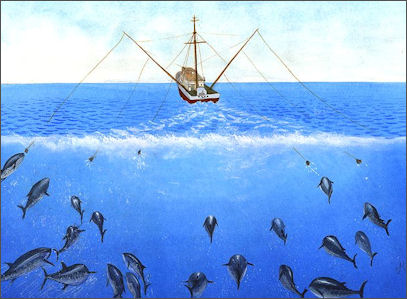
Trolling for tuna, better ecologically than longlines Bottom longlines have a mainline weighted to the seafloor with buoy lines marked by flags on either end, called high flyers. Leaders, called gangions or snoods, with baited hooks are attached to the mainline. A longline set can have up to a thousand baited hooks and once deployed can soak anywhere from hours to days. Target species include sharks, halibut, flounder, sole and other groundfish [Source: NOAA]
Risks to Sea Turtles: Many species of sea turtles feed along the bottom and can become entangled in branching gangions or may be atttracted to lightsticks attached near baited hooks. A hook can penetrate the turtle's flippers, head, mouth, or neck. If swallowed, an entire hook can become lodged in the turtle's digestive tract, hindering normal feeding and digestion and possibly leading to starvation or death. Loggerheads are most often hooked in the mouth or esophagus while leatherbacks are commonly hooked around the front flippers. Line entanglements can cause constriction of the lines on the turtle's soft body parts leading to severe lacerations and infections. Turtles entangled or hooked at depth likely drown because they cannot reach the surface to breathe.
Risks to Marine Mammals: Bottom longlines pose less of a threat from incidental hooking to marine mammal species that feed in shallower depths. However, injuries and entanglements can occur from vertical lines attached to surface buoys and in derelict gear. These interactions can lead to lacerations, puncture wounds, exhaustion from entanglement, and drowning.
Bycatch Reduction: NOAA Fisheries implemented regulations in 2005 to reduce bycatch in bottom longlines by requiring: 1) Sea turtle release gear and handling instructions onboard reef fish vessels to facilitate the safe release of any sea turtles or smalltooth sawfish. 2) Closures of certain fishing areas at certain times (time/ area closures). 3) Fishing effort restrictions that limit the number of hooks per vessel. 4) Certain fisheries are also encouraged or required to carefully catalog and document bycatch through self-reporting and observer coverage in order to monitor the dynamics of incidental takes.
Hook and Line Fishing
Hook and Line fishing is a method fishing based on the same principals as rod and reel fishing practiced by sport and recreational fishermen. Hand lines, hand reels and powered reels (also called rod-and-line fishing or deepwater line fishing) are used commercially to target finfish. Hand lines are the simplest form of fishing; they consist of one or more baited hooks attached to a line, which is retrieved by hand. They may be used singly or several at a time. Hand reels can be mounted on the side of a vessel or attached to a rod (rod and line). [Source: Australia Fisheries Research & Development Corporation]
Rod and line is the predominant method used by recreational fishers. Reels are used to deploy and retrieve the line and are usually fitted with a drag system (a 'brake' system, which is designed to create resistance in the reel as the fish takes out line). To reduce the time and effort involved in setting and hauling the line, electric or hydraulic motors may be fitted to some larger reels (powered reels).
Pole and line (also called poling) consists of a fibreglass pole and a short line with a barbless lure attached. This method of fishing typically targets pelagic species such as tuna. The fish may be attracted to the boat by throwing bait into the water or by disturbing the surface of the water using water sprayers, mimicking the behaviour of baitfish. As fish are hooked on the lure, they are hauled over the fisher's shoulder onto the deck. Larger fish are taken using a double poling arrangement, operated by two fishers.
Trolling
Trolling is a simple method of fishing in which lines with baits or lures are towed behind a vessel as it moves along at a speed of 2–10 knots. Most commercial operations use lines rigidly mounted to the stern of the vessel or off outriggers or booms, and troll 3–18 lines at once. A variety of lines, rig designs, and lures or baits are used for trolling. [Source: Australia Fisheries Research & Development Corporation]
Trolling is considered one of the most environmentally-friendly forms of fishing. Consumer should look for the “troll-caught” label to make sure the fish you buy are not caught with long lines. Trolling is a method of fishing where one or more fishing lines, baited with lures or bait fish, are drawn through the water. This may be behind a moving boat, or by slowly winding the line in when fishing from a static position. Trolling is used to catch pelagic fish such as salmon, mackerel and kingfish. [Source: Wikipedia]
Trolling can be phonetically confused with trawling, a different method of fishing where a net (trawl) is drawn through the water instead of lines. Trolling is used both for recreational and commercial fishing whereas trawling is used mainly for commercial fishing. Trolling from a moving boat involves moving quite slowly through the water. This can be accomplished with the use of a special trolling motor. Multiple lines are often used, and outriggers can be used to spread the lines more widely and reduce their chances of tangling. Downriggers can also be used to keep the lures or baits trailing at a desired depth.[Source: Wikipedia]
Purse Seine Nets
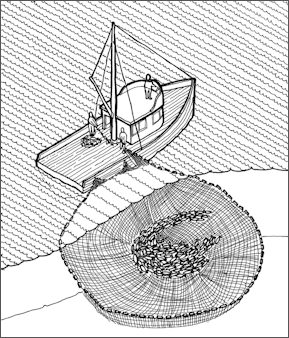
purse seine net
A purse seine is a large wall of netting deployed around an entire area or school of fish. The seine has floats along the top line with a lead line threaded through rings along the bottom. Once a school of fish is located, a skiff encircles the school with the net. The lead line is then pulled in, "pursing" the net closed on the bottom, preventing fish from escaping by swimming downward. The catch is harvested by either hauling the net aboard or bringing it alongside the vessel. Purse seines can reach more than 2,000 meters (6,500 feet) in length and 200 meters (650 fee) in depth, varying in size according to the vessel, mesh size, and target species. Target species include Schooling pelagic fish of all sizes, from small sardines to large tunas and squid. [Source: NOAA]
Risks to Sea Turtles: Purse seining is a non-selective fishing method that captures everything that it surrounds, including protected species. Sea turtles can be captured by a purse seine as it is set and then become entangled in the net mesh as it is hauled in. Entangled turtles may sustain injuries to their flippers and shells due to the force of the net as it is hauled. In a large catch, turtles risk being crushed under the sheer weight of the tow. Captured turtles can be released alive if they are quickly retrieved and removed from the net.
Risks to Marine Mammals: Purse seines can easily encircle marine mammals along with target species as the net is set. Historically, dolphin pods were even used as a natural cue visually leading purse seiners toward areas of abundant schooling fish (called "setting on dolphins"). Once the netting has been set, encircled marine mammals cannot escape and can become entangled, injured, or stressed. Even with quick retrieval, marine mammals' sensitive bodies and internal organs cannot usually withstand the weight of the catch or the impact of being placed on the vessel. In U.S. fisheries, species most commonly captured include bottlenose dolphins and humpback whales.
Bycatch Reduction: Currently no regulations exist for minimizing bycatch of protected species in purse seine fisheries. Employing fisheries observers who scan the water prior to setting nets is the most effective way of minimizing incidental capture.
Purse Seine Fishing
Purse seine nets are named for their conical purse-like nets which are drawn closed from the bottom. The circular net is typically about 1,500 feet long and 150 feet deep. At the end of the net is a buoy that is dropped in the water. The net is then released from the fishing boat as the vessel goes in a circle back to the buoy. Once the net is completely laid out a rope is drawn which closes the bottom of the net. The net is then pulled in until the fish are confined to a small area and then scooped out with a power-operated dip net. Large purse seine nets are deployed by a pair of boats, one on each end of the net. Some operations employ fishing vessels that scoop up a catch and dump it into the hold of a factory ship.
Ideally purse seine nets are used to ensnare entire schools of fish. They create a vertical wall of net, capable of surrounding a large school. When a winch pulls the bottom closed like a drawstring purse everything inside is trapped. Advanced purse seine vessels, equipped with powerful sonar and, cost around $5 million each and can encircle 3,000 adult bluefin tuna, valued at around $7 million.
Finding a school of fish is one of the most difficult steps of this fishing technique and include: Natural cues such as a congregation of seabirds, ruffling of surface water and/or fast moving groups of dolphins. Helicopters scanning the water for natural cues from the air to direct boats toward schooling fish. Using radar fish finders to help identify the exact location and size of a school. [Source: NOAA]
Traps and Pots
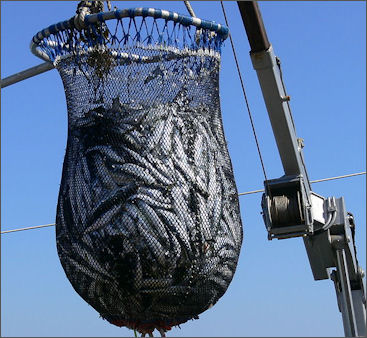
Purse seine catch Traps and pots are submerged three-dimensional wire or wood devices that permit organisms to enter the enclosure but make escape extremely difficult or impossible. Bait is commonly secured in the trap to lure organisms inside, where they wait until fishermen return to retrieve the catch and re-bait the traps. Most traps are attached by a rope to a buoy on the surface of the water. Traps can be set individually or in a long continuous series, called trawls, at depths up to 2,400 feet (730 meters). Gear size, configuration, and hazards to protected species differ depending on target species. Target species include bottom-dwelling crustaceans and mollusks, crabs, lobsters, whelk, fish, scup, black sea bass and eels. [Source: NOAA]
Risks to Sea Turtles: The vertical lines running from the trap to the surface buoy can entangle sea turtles, particularly leatherback turtles, around the flippers, neck, or carapace. If traps are heavily weighted, turtles can drown because they cannot reach the surface to breathe. Some fishermen attribute broken or disfigured pots and traps to sea turtles that have attempted to eat the bait or catch inside. However, these depredation attempts do not commonly lead to injury or entrapment.
Risks to Marine Mammals: The lines connecting traps to each other (groundlines) or to the surface buoy (vertical lines) can entangle marine mammals. Large or small cetaceans can become entangled around their bodies and fins, leaving lacerations that can lead to infection. Large whales, including endangered North Atlantic right whales, humpback whales, fin whales, and grey whales, are particularly susceptible to becoming entangled in trap or pot gear due to spatial overlap with fisheries and their feeding behavior. The effects of entanglement can range from no permanent injury to serious injury and death. If the traps are weighted down, entangled whales and dolphins can drown if they cannot reach the surface to breathe.
Bycatch Reduction: 1) Culling rings may be added to a section of a trap or pot to allow undersized animals to escape, but this approach does not minimize injury to marine mammals or turtles. 2) Weak links and breakaway lines are fishing gear modifications that can minimize injury and mortality by allowing the animal to break free from the gear and reach the surface to swim away with minimal trailing lines. 3) The use of sinking groundlines between traps instead of floating groundlines, that arc up into the water column, also minimizes the risk of entanglement. 4) Reducing the number of buoy lines in the water column by trawling up, or adding more traps per trawl, should reduce risks to protected species. However, the level of risk reduction cannot be quantified because the current number of vertical lines is unknown. Reducing the number of vertical lines will likely directly improve the entanglement risk presented by vertical buoy lines.
Pound Nets
Pound nets are a series of nets anchored to the bottom perpendicular to shore and are set in nearshore areas. Pound nets consist of a fence leader that interrupts the movements of target species and a heart that funnels fish into the trap (pound) via a no return mesh tunnel. The series of nets are anchored to the bottom perpendicular to shore and are set in nearshore areas, with depth often increasing toward the pound. The netting usually reaches above the waterline with the pound open at the surface. Pound nets are harvested by concentrating the catch in one corner and removing it with a dip net. The leaders may be as long as 1,300 feet (400 meters) with pounds measuring 160 square feet. Target species include bluefish, catfish, menhaden and flounder [Source: NOAA]
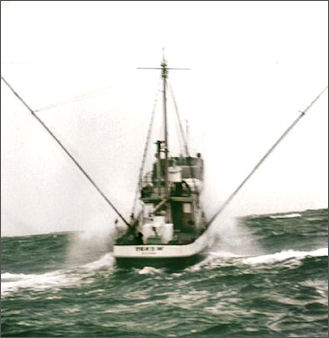
trolling vessel Risks to Sea Turtles: Populations of loggerhead, Kemp's ridley, and leatherback sea turtles are at risk in areas where pound net fishing is abundant, such as the Chesapeake Bay and surrounding waters. Sea turtles may become entangled in any portion of the pound net, most commonly around their head and front flippers. Entanglements can result in bodily injury or drowning. Entrapment occurs when a sea turtle finds its way into a pound net but cannot get out. Sea turtles may also become pinned against the netting in a fast moving current and drown if they cannot free themselves.
Risks to Marine Mammals: Small coastal cetacean species, such as bottlenose dolphins, can become entrapped and or entangled in pound nets. The mesh netting of leaders can act like a gillnet and entangle dolphins. Because the nets are often at or near the surface, cetaceans may be able to breathe until they are released. Once an animal is caught, stress may lead to bodily injury, with strong currents often complicating entanglements.
Bycatch Reduction: Regulations require modified leaders (composed of stiffer materials) to be set more than 10 feet from the low waterline during the summer to reduce turtle bycatch in Virginia. Use of stiffer materials in the leaders has likely lowered dolphin entanglement as well.
Image Sources: Wikimedia Commons, National Oceanic and Atmospheric Administration (NOAA) Text Sources: New York Times, Washington Post, Los Angeles Times, Times of London, Yomiuri Shimbun, The Guardian, National Geographic, The New Yorker, Time, Newsweek, Reuters, AP, Lonely Planet Guides, Compton’s Encyclopedia and various books and other publications.
Last updated April 2023
